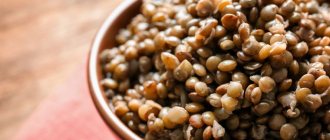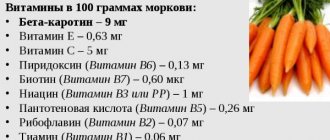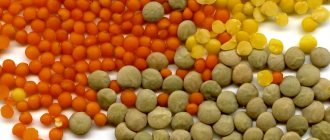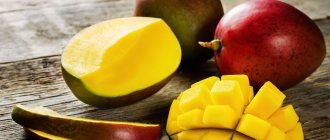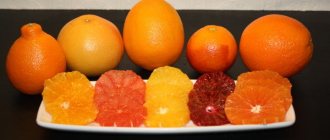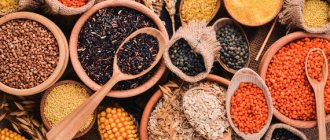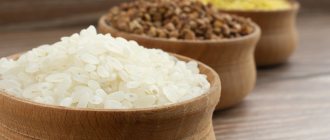Chemical composition of different types of lentils, calorie content, BZHU, GI
Lentil cereals are a legume.
There are its varieties:
- brown;
- red;
- yellow;
- green;
- black.
The crop is found in both small-seeded and large-seeded varieties.
| Lentil type | Calorie content (per 100 g) | GI | BJU (per 100 g) |
| brown | 303.75 (1271 kJ) | 30 | BZHU -24.25 g, 1.38 g, 48.23 g. % of the daily value of BZHU - 36%, 1%, 18% |
| green | 282.47 kcal (1182 kJ) | 25 | BZHU – 23.09 g, 1.35 g, 47, 16 g. % of the daily norm BZHU – 34%, 1%, 17%. |
| yellow | 272 kcal(1138 kJ) | 30 | BZHU-23 g, 1.30 g, 43.40 g % of the daily value of BZHU – 34%, 1%, 16%. |
| red | 292.65 kcal (1225 kJ) | 30 | BZHU -21.02 g, 1.10 g, 47.39 g. % of the daily norm of BZHU - 31%, 1%, 17%. |
| black | 337 kcal(1410 kJ) | 25 | BZHU – 23.20 g, 1.20 g, 58.40 g. % of the daily value of BZHU – 34%, 1%, 16% |
The protein content in this legume is 26-32%. The chemical composition of lentils contains 21 amino acids, 12 of which are essential (arginine, threonine, tryptophan).
Lentil protein of any type is similar in composition to animal protein and is therefore completely and easily digestible. For this quality, lentils are held in special esteem by vegans and vegetarians, as they not only allow them to obtain an important micronutrient without consuming meat, but also diversify their diet.
Lentils are rich in vitamins, microelements and substances such as:
- iron – 0.1 kg of lentil grains contains 7.7 g of iron, which is necessary for the normal formation of blood cells and the prevention of anemia, which is especially important for children, women during gestation and people who do not eat meat. In order for this important microelement to be completely absorbed, lentils are eaten together with herbs, fresh, boiled and stewed vegetables;
- B1 (thiamine) – important for the normal functioning of the nervous system, heart function, and adrenal glands. Participates in the formation of proteins and nucleic acids, regeneration processes;
- B9 (folic acid) – prevents the development of intrauterine anomalies, therefore it is extremely important for pregnant women and children. It also prevents the development of cancer cells and radiation sickness;
- B2 (riboflavin) – normalizes the functioning of the gastrointestinal tract, improves the tone of blood vessels, the condition of the dermis and vision;
- PP (nicotinic acid) – increases endurance, performance, participates in all metabolic reactions in the body;
- K (vicasol) – responsible for blood clotting, elasticity and vascular permeability;
- E (tocopherol) – protects against vascular sclerosis, muscular dystrophy;
- carothionides are substances responsible for redox reactions. They influence the level of sugar and cholesterol in the blood, stimulate regeneration in tissues;
- phytoestrogens are substances that imitate the female sex hormone estrogen. They help with menopause, inhibit the development of tumors of the female genital area, and ease the course of menopause;
- the other minerals contained have a beneficial effect on the entire body. Potassium is necessary to maintain cardiac activity, magnesium protects against seizures, improves blood circulation, manganese acts as a powerful antioxidant. 0.1 kg of lentil grain contains the daily requirement of molybdenum, which is involved in purine metabolism.
Lentils and their health benefits
The grains are highly nutritious; when grown, they do not accumulate nitrates and other harmful substances. Dishes made from them quickly satiate and relieve hunger for a long time.
The fibrous structure cleanses the intestines of toxins and waste. The benefits of lentils for the body are not limited to this. Iron in the form of safe organic compounds improves blood composition, stimulates the production of red blood cells and is involved in the synthesis of many enzymes.
Adding to the diet will provide relief for the following conditions:
- blood problems and anemia,
- heart and vascular diseases,
- decreased immunity,
- diseases of the digestive system.
The product replenishes the deficiency of vitamins and minerals, supplies the body with complete protein, which is easily digested, relieves constipation, reduces the likelihood of developing depression and improves overall well-being.
Can you eat lentils if you have diabetes? The low glycemic index and the presence of complex carbohydrates allow us to classify it as a product useful for this condition.
Red lentils: benefits
Red lentils
This variety improves metabolism and gives a long-lasting feeling of fullness. At the same time, the dishes do not overload the gastrointestinal tract and are useful for the following conditions:
- arterial hypertension,
- rheumatism,
- anemia,
- cholecystitis,
- hepatitis,
- gastritis and stomach ulcers.
Green lentils: benefits
Its taste is brighter than other varieties. When cooked, grains retain their shape better; dishes based on them will bring improvement in the following diseases:
- nervous disorders,
- constipation,
- inflammation, inflammation
- carbohydrate metabolism disorders.
Cereals prevent the development of diabetes, reduce the need for insulin, and are useful for menstrual irregularities.
For men's health
The benefits of lentils are beyond doubt. For men, it is valuable as a product that relieves sexual dysfunction. Dishes made from it strengthen the genitourinary system, improve blood circulation, relieve inflammation and increase sperm motility.
The benefits of lentils for a woman’s body
The use of the product becomes especially important during menopause and menopause. Isoflavones prevent the development of tumors, and phytoestrogens protect against irritability, improve skin condition, strengthen joints and eliminate swelling. Plant analogues of female sex hormones help slow down aging, reduce sweating and get rid of hot flashes.
Lentils for women of any age are a healthy and healthy food. It is added to the menu for painful menstruation and migraines. It has a beneficial effect on the course of pregnancy and increases the likelihood of conception.
Lentils for weight loss. Inclusion in the daily diet promotes weight loss. They successfully replace meat products, reducing the consumption of animal fat. Plant fibers are the key to good digestion and proper metabolism.
For children
Grains strengthen the growing body and improve brain activity. Whether children can eat lentils depends on their age and health status. This is a difficult product for a child's digestive system. Up to 2 years, it is better to use it as part of other dishes: soups or casseroles. It is best not to serve this product as a stand-alone side dish to a child under 3 years of age.
Beneficial properties of boiled lentils in dietary nutrition
Lentils boiled in water, which is low in calories, are successfully used in dietary nutrition. After cooking, the calorie content of this product is 117-178 kcal per 100 g.
Lentils boiled in water. Calorie content
- the carbohydrates contained in boiled lentil grains are “slow”, which promotes the burning of fat layers and “accelerates” metabolic processes;
- the abundance of insoluble dietary fiber allows you to normalize the functioning of the digestive tract, improve peristalsis and intestinal flora. Fiber also removes toxins and helps maintain glucose and cholesterol at a safe level;
- the fiber contained gives you a feeling of fullness for a long time;
- the low glycemic index of boiled lentils makes it possible to use it in diabetics;
- stimulates the body's defenses, protects against cancer;
- the amino acids contained regulate metabolism. Methionine helps burn fatty tissue, leucine is important for bone and muscle tissue, threonine protects the liver from fatty degeneration, tryptophan synthesizes the happiness hormone serotonin.
Nutritional and energy value
100 g of dry lentil seeds contain 297 calories; during cooking, their amount decreases to 115 kcal. The nutritional value of the plant depending on the condition of the product is presented in the table:
| BJU | Dry, g/100 grams | Boiled, g/100 grams |
| Squirrels | 23 | 9 |
| Fats | 1,6 | 0,4 |
| Carbohydrates | 46,2 | 20,1 |
The energy value of lentils can vary among its varieties:
| Lentil type | Calorie content, kcal |
| Red | 313,87 |
| Green | 323 |
| Yellow | 298,73 |
| Black | 324 |
Calorie content may vary depending on the method of preparation of the product:
| Lentil category | Calorie content, kcal per 100 g of product |
| Sprouted, raw | 106 |
| Sprouted, fried with salt | 101 |
| Sprouted, boiled in water | 112 |
| Canned | 110 |
| Boiled | 111 |
| With vegetables | 137,3 |
The following vitamins are most widely represented in the products:
- IN 1;
- AT 2;
- AT 3;
- AT 5;
- AT 6;
- AT 9;
- WITH.
The chemical macroelements that make up lentils include:
- manganese;
- phosphorus;
- potassium;
- zinc;
- iron;
- copper;
- magnesium;
- sodium;
- calcium;
- selenium.
Lentils are rich in the following microelements:
- boron;
- titanium;
- silicon;
- molybdenum;
- nickel;
- cobalt;
- fluorine;
- iodine;
- zinc.
The medicinal properties of lentils that affect health are as follows:
- improving intestinal motility, eliminating diarrhea, constipation, diverticulosis and other gastrointestinal disorders;
- normalization of the condition of the hair and skin;
- strengthening the immune system;
- improving the absorption of ascorbic acid;
- replenishment of iron deficiency in the blood, protection against anemia;
- prevention of the development of gastritis, ulcers and other diseases of the stomach and duodenum;
- preventing infertility;
- normalization of the functioning of the thyroid gland and the endocrine system as a whole;
- stimulation of mental activity, increased physical endurance, accelerated recovery and calmness after stressful situations;
- prevention and treatment of pancreatitis;
- help with type 2 diabetes;
- stopping cancer cells and stopping further development and spread of tumors;
- restoration of psycho-emotional background;
- prevention of arrhythmia development;
- acceleration of metabolic processes;
- restoration and cleansing of the liver;
- improvement of the condition of the skin of the face and body.
Harm and contraindications for use
Lentils boiled in water, the calorie content of which allows you to prepare light dietary dishes from it, is not healthy for everyone. There are a number of contraindications to the use of this legume.
After consuming lentils, flatulence may occur, so people suffering from enterocolitis, dysbacteriosis, gastritis, and cholelithiasis are better off avoiding consuming lentil grains. You can’t eat it if you have hemorrhoids.
The content of natural purines will be an obstacle to the inclusion of lentils in the diet of patients with arthrosis, arthritis and gout.
When purines break down, uric acid is formed, which can provoke an exacerbation of these diseases. You should not eat lentil dishes before bed. It is forbidden to eat raw lentils, as they contain toxic substances phasin and phaseolunatite, which can cause poisoning.
Harm of red lentils
Harmful consumption of red lentils can be traced only in cases of individual intolerance. In other cases, red lentils are very well digestible and their benefits are invaluable, except in cases where they are contraindicated.
Lentils can be harmful to people who suffer from prolonged digestion of food. Since legumes provoke gas formation in the intestines and a person’s well-being depends on the duration of digestion.
The product is often consumed with meat, vegetables or copious amounts of spices. This combination can also be harmful due to the mixing of animal and vegetable protein and the fact that the meal will have a high calorie content.
Lentils can also harm people:
- with dyskinesia of the gallbladder;
- with incipient gout or primary joint diseases;
- those suffering from digestive problems;
- with dysbacteriosis.
Research on lentils shows that a large amount of protein in the product can lead to a deterioration in the body's metabolic processes.
How to cook lentils correctly
Cooking lentils of any variety must follow certain rules:
- First, the grains should be sorted and cleared of debris, then washed under running water;
- some varieties require pre-soaking;
- cooking liquid is taken twice as much as grains;
- Before boiling, cook the beans over moderate heat, and then over low heat, while removing the noise (foam);
- add some salt to the legumes towards the end of cooking;
- stir the boiling grains periodically to prevent them from burning;
- Cooking time will depend on the type of lentil;
- You are allowed to add your favorite usual spices and combine them with fried vegetables from onions and carrots, peppers and tomatoes.
Green lentils hold their shape best when cooked and will look good in dishes that call for the whole beans, such as salads. This type requires pre-soaking for 60-120 minutes in cold water. After this time, the liquid is drained and the grain is filled with clean new water. Bring to a boil over moderate heat and cook for about 40-45 minutes.
Brown lentils hold their shape almost as well as green ones. Soups, stews, and casseroles are prepared with it. Brown lentils can be soaked in water for less time before cooking than green lentils, about 40-60 minutes. After soaking, the grains are poured with fresh water. After boiling, continue cooking over low heat for 30-35 minutes.
Red and yellow lentils do not need to be soaked before cooking. It boils very well and is used for porridges, thick soups, and purees.
After boiling, the washed grains are boiled for 15-20 minutes. Black lentils can be cooked without soaking, while retaining their shape perfectly. However, experts still recommend soaking this species for 2-3 hours before cooking to remove antinutrients and increase nutrient absorption. Cook black lentils for 30-40 minutes.
Lentils - how to cook correctly?
In cooking, lentils are used as a separate side dish or base for soups, as flour for baking or even to make gluten-free pasta. In addition, lentils go well with any vegetables - and are best combined with carrots, tomatoes and pumpkin.
The simplest option for cooking at home is to cook porridge - red lentils take about 10 minutes, and brown ones - up to 40 minutes. By adding pre-fried onions or garlic, the dish acquires piquant notes. Fresh herbs will also work.
Among other things, in Indian cuisine, lentils are always cooked with seasonings - the classics are curry, turmeric and paprika, as well as hot red pepper. Tougher, darker lentils can be used in cold salads because they do not get soggy when cooked.
***
New Fitseven materials, 5 times a week - in telegram:
- fit7seven
Lentils are one of the oldest agricultural crops. It is distinguished by its high protein and fiber content - due to which it is beneficial for the body and can act as a substitute for meat. In addition, lentils contain many minerals necessary for metabolism.
Scientific sources:
- Lentils, raw Nutrition Facts & Calories, source
- Lentils Nutrition: Weight & Blood Sugar Supporter or Digestion Disruptor?, source
- Effect of processing on some antinutritional factors of lentils, source
Lentil diet. Rules and principles of nutrition
A lentil diet can be softer or harsher. Under strict strict restrictions, consumption of only lentil porridge without any additives (salt, spices, oil) is allowed. You can eat it in any quantity, but in practice you won’t be able to eat a lot of lentils at one time, since they are filling. The abundance of fiber promotes rapid swelling and a feeling of fullness.
But thanks to this, it is possible to lose weight quite quickly and lose 4-5 kg in 6-7 days.
Lentils boiled in water, which are low in calories, are also included in more gentle diets that allow the consumption of other low-fat foods. In this milder version, you are allowed to eat vegetables, fruits, yogurts, kefir, lean meat, and rye bread.
Those who want to lose weight on a lentil diet should remember the following points:
- The downside of this product is the appearance of flatulence. The diet is not suitable for people with gastrointestinal diseases;
- in order to reduce gas formation, it is better to choose red lentils without the shell;
- Also, to prevent flatulence, raw grains can be ground in a coffee grinder. When grinding, the shell and dense fibers will be destroyed, and subsequently their absorption will be smoother;
- It is advisable to pre-soak any type of lentil. Thanks to this, there will be fewer substances that provoke the formation of excess gases.
- to reduce bloating, it is allowed to add cumin, bay leaf, dill, and ginger to the water during cooking;
- if you experience loose stools, pain and cramps in the abdomen, or nausea, you should stop following the diet;
- The drinking regime throughout the entire period of following the diet should be well established.
Contraindications
Any legume causes gas formation in the intestines, so lentils are contraindicated for people:
- with ulcers of the digestive system;
- with stones in the gall bladder and kidneys;
- with complaints about digestion and its speed;
- patients with gout;
- having abundant salt deposits in the joints.
Anyone who suffers from digestive disorders should pay special attention.
Also, legumes and lentils in particular should not be consumed if there is a danger of exacerbating chronic diseases.
Diet menu for the week
A sample menu for 7 days might look like this:
| Breakfast | Snack (2nd breakfast) | Dinner | Afternoon snack | Dinner | |
| Mon | lentil porridge | apple | vegetable soup with lentils | low fat cottage cheese | lentil cutlets with seaweed |
| VT | lentil flatbread and boiled egg | yogurt (no sugar) | Lentil puree, stewed rabbit meat | fruit juice, banana | boiled lentils with spinach |
| SR | lentil porridge | glass of kefir | creamy soup with lentils and pumpkin | rye bread, hummus | lentils with champignons |
| Thu | Lentil puree | a glass of plant milk (rice, oatmeal) | lentils with stewed vegetables | coconut cream with berries | Vegetable Salad |
| PT | repeat Mon menu | ||||
| SB | repeat BT menu | ||||
| Sun | repeat to select menu Wed or Thu | ||||
How to choose lentils
When choosing lentils for your diet, you can rely on personal taste preferences. The brown variety has a nutty flavor and is good for side dishes and first courses. Green lentils have the thickest shell and contain more fiber than other types. This type retains its shape, has a spicy, spicy flavor and is suitable for salads.
Red lentils do not have a shell, so they cook faster than other types and are ideal for pureed soups. Black lentils are universal, and yellow lentils are in many ways similar to green ones, as they are obtained after peeling the green lentil grains from the shell. As for the rules for purchasing lentil grains, you should pay attention to the date of manufacture, safety and integrity of the container (package).
The following signs indicate that lentils are of high quality:
- pleasant aroma reminiscent of nuts;
- no damage to the packaging;
- clean and smooth beans;
- absence of foreign impurities, litter, bugs, mold;
- the beans are approximately equal in size and color;
- there is no condensation (moisture) in the packaging;
- the beans do not stick together and are easily poured into the package.
If the integrity of the packaging is compromised, there is a suspicious smell, insects, or there are beans of different colors in the same container, you should not buy such lentils.
Recipes for dietary dishes with boiled lentils
Many people avoid this product because they have little idea what can be prepared from it. This legume can be used to make flatbreads, cutlets, pureed soups, salads and side dishes.
Lentil puree
Ingredients used:
- lentil grains – 250 g (1 whole glass);
- water – 500 ml (you can use lean meat or vegetable broth);
- vegetable oil - 1-2 tbsp;
- laurel -1-2 small leaves;
- greens – chopped dill.
Preparation progress:
- Legumes are soaked for 30-40 minutes;
- The grains are immersed in water and brought to a boil over moderate heat, then boiled for about another 20 minutes;
- After the time has passed, turn off the fire, add a bay leaf and keep the legumes in water under the lid for another 5-7 minutes;
- The liquid is drained, the boiled lentil grains are blended with a blender (immersion or placed in a bowl), oil is added. Before serving, sprinkle with dill.
Cream soup
It differs from puree in the number of ingredients and a more liquid consistency.
For preparation take:
- onion (medium) – 1 pc.;
- carrots – 1 pc.;
- water or broth (vegetables, chicken) -1-1.5 l (about 5 glasses);
- garlic – 1-2 cloves;
- lentils (preferably red) – 350-400 g;
- greens - dill, parsley.
Preparation progress:
- The legumes are pre-soaked for 35-40 minutes.
- After the time has passed, the water is drained, the grains are poured with broth and placed on the stove, boiled for 20-25 minutes.
- The onion is chopped into small pieces, the carrots are chopped on a grater and sauteed in vegetable oil (olive oil is possible).
- Add roasted vegetables, crushed garlic, bay leaves to the boiling lentils and keep on fire for another 7-8 minutes.
- After turning off the soup, let it sit for a while and garnish with herbs before serving. If the lentil grains are not cooked well, you can puree the soup with a blender.
Lentils with meat
Meat served with a lentil side dish is an excellent alternative to the usual buckwheat, rice, and potatoes. When on a diet, you should give preference to dietary types of meat: turkey, chicken breast, lean pork, rabbit, and veal.
For preparation take:
- 1 cup lentil grains;
- 500 g of meat (any of the above);
- carrot;
- onion;
- seasonings to taste.
Preparation will not take much time:
- The meat is cut into small pieces and sent to the frying pan;
- Chop the onion and carrots and add to the meat, fry for 8-10 minutes. together;
- Pre-cleaned and soaked lentils are boiled for 20-40 minutes. (depending on the variety);
- The cooked grain is filtered from the liquid and combined with frying meat and vegetables, left to simmer over low heat for another 15-20 minutes. At the end, flavor enhancers are added - bay leaf, peppercorns, a little salt.
Lentil flatbreads
Flat lentil buns are very filling and can also be eaten on a diet:
- lentil grains (red) – 200 g;
- flour – 2-2.5 tbsp;
- yeast – 6 g;
- onion – 1 pc.;
- sugar – 1 tsp;
Cooking steps:
- Lentils are pre-soaked for 1.5 -2 hours;
- After soaking, the grains are boiled and cooled, after which they are punched in a blender to a mass without lumps.
- For the dough, mix sugar, 1 tbsp in a container. flour, 3 tbsp. warm water with yeast and leave for 10-15 minutes.
- When the dough rises, combine it with lentils and add a spoonful of vegetable oil. Allow the mass to rise.
- The onion is chopped into small pieces and fried.
- The dough combined with lentils should increase, after which flour, fried onions, and salt are added to it. Flour is introduced gradually, sifting it at the same time. Slowly knead the dough.
- The dough is divided into 9-10 parts and kneaded with your hands, giving the flatbreads a rounded shape.
- Place the flatbreads on a greased baking sheet lined with parchment and bake for 20-25 minutes. at 200C.
Vegetable salad with lentils
A salad of seasonal vegetables and lentil grains is perfect for dinner, as a complement to meat dishes. For salad, it is better to take a green variety of lentils, which does not boil so much and retains its shape.
- bell pepper;
- Cherry tomatoes);
- cucumber;
- parsley dill;
- 150 g boiled lentils;
- olive oil.
The amount of vegetable ingredients is selected depending on taste preferences. Boil the lentils and let cool. Vegetables are chopped, combined with lentils, seasoned with oil and sprinkled with herbs.
Despite the fact that lentils are not a very familiar product for most people, dishes with them are tasty, satisfying and healthy. The low calorie content of this boiled grain allows it to be included in dietary dishes. Porridges, soups with water and broth, salads and side dishes with lentils can significantly diversify your daily diet.
Calorie content of lentils
The calorie content of lentils is 119 kcal/100 grams of product. The nutritional value of lentils is:
- Proteins - 9.0 g;
- Fats - 0.6 g;
- Carbohydrates - 22.1 g.
The glycemic index of lentils is 30. Due to the low calorie content of lentils, as well as the presence of complex carbohydrates in its composition (the dietary properties of lentils), the product can be included in a weight loss program for overweight people.
